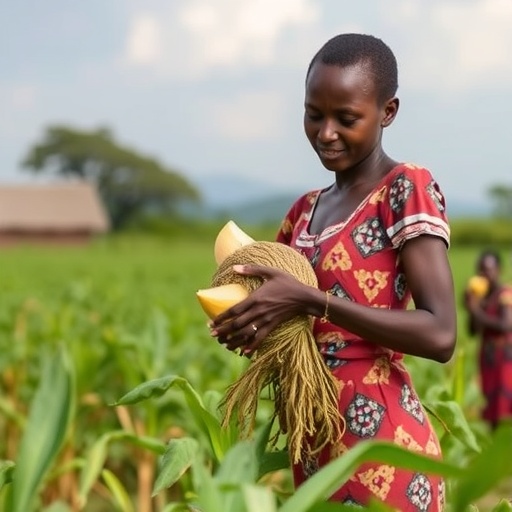A groundbreaking study led by an international team of researchers has challenged long-held assumptions about Africa’s ability to combat widespread micronutrient deficiencies, commonly known as ‘hidden hunger,’ solely through domestic agricultural expansion. Published in the prestigious journal Nature Food, the study provides a comprehensive, continent-wide analysis of nutrient gaps across all 54 African countries, going far beyond the traditional focus on calorie sufficiency. This research uncovers the stark reality that expanding farming activities within existing land and water constraints is insufficient to meet the nuanced nutritional needs essential for the health and development of Africa’s diverse populations.
The investigation pioneers a holistic approach, measuring not only caloric intake but also crucial micronutrients such as iron, calcium, zinc, protein, and vitamin A, among others. This methodology marks a significant advancement, as previous assessments have predominantly concentrated on caloric adequacy, thereby obscuring the more insidious problem of micronutrient malnutrition that plagues millions in Africa. Iron deficiency, for instance, which directly contributes to high rates of anemia and associated morbidity, was detected in every single African nation. These findings illuminate a deeply entrenched challenge that requires urgent and multifaceted solutions, beyond mere increases in food quantity.
At the core of the study’s findings is the recognition that African countries face formidable resource constraints, particularly limited arable land and freshwater availability. Sustainable farming requires adhering to ecological thresholds to avoid exacerbating land degradation and water scarcity issues already intensifying under climate change pressures. The researchers define water constraints by setting a ceiling at 20% of national total runoff and land constraints according to the potentially available cropland, thereby grounding their analysis in realistic environmental limits. Under these constraints, only seven out of the 54 countries examined were predicted to feasibly meet their nutrient requirements through domestic production alone.
This research highlights an urgent need to shift perspective, emphasizing not just self-sufficiency in calories but a broader nutritional security paradigm that incorporates micronutrient sufficiency within sustainable agricultural frameworks. Co-author Dr. Pan He from Cardiff University underscores this point by illustrating how focusing narrowly on caloric intake masks the devastating public health impacts of deficiencies in vitamins and minerals, which silence developmental potential and fuel cycles of poverty and disease across populations.
More strikingly, the study details the complex trade-offs inherent in agricultural expansion. Increasing farmed land and water use may provide additional calories but comes at an enormous environmental and socioeconomic cost. Land conversion often disrupts ecosystems, reduces biodiversity, and depletes soils, while water diversion pressures already scarce resources, undermining the resilience of rural communities dependent on these natural systems. These constraints fundamentally limit the potential for domestic farming efforts to close the micronutrient gaps at a national scale.
The research team utilized extensive datasets from authoritative international organizations including the Food and Agriculture Organization (FAO) and the World Health Organization (WHO), ensuring robust, transparent, and internationally comparable analyses. Their approach incorporated national food production statistics, nutrient composition data, and recommended nutrient intake values, which were carefully calibrated to reflect food quantities ‘ready to be consumed’ after typical preparation and cooking losses — factors often neglected in less rigorous studies.
The implications of these findings are profound. Policy-makers, development practitioners, and public health experts are urged to reconsider interventions that solely promote increased domestic food production. Instead, the study advocates for diversified strategies that integrate productivity enhancements such as the adoption of nutrient-dense crops and advanced farming technologies, alongside systemic improvements in reducing post-harvest food loss and waste. Notably, the research highlights that nutrient availability is currently diminished by 9-15% due to inefficiencies along the food supply chain—a bottleneck that represents a significant yet addressable obstacle.
Lead author Professor Xu Zhao from Shandong University emphasizes the gravity of the micronutrient deficit challenge, noting that it underpins critical issues including widespread anemia, vulnerability to infectious diseases like malaria, and the stark rates of infant and child mortality seen across many African countries. Resolving these nutritional deficiencies is not merely a matter of agricultural policy but one intimately tied to broader efforts in health, climate resilience, and socioeconomic development.
Looking forward, the research team is exploring complementary avenues to bridge the nutrient gaps identified. These include potential innovations such as fortified foods, dietary supplements, and biofortification of staple crops that can provide targeted micronutrient boosts. Moreover, by delving into more granular regional and household-level data, the researchers aim to expose inequalities in nutrient access within countries, laying groundwork for more equitable and effective nutrition policies.
This study, therefore, redefines the challenge of ending ‘hidden hunger’ in Africa. It calls for integrated approaches that transcend traditional agriculture-centric paradigms by balancing ecological sustainability with nutritional adequacy. The insights offered by this continent-wide nutrient gap analysis provide invaluable guidance for the urgent task of crafting resilient, inclusive, and health-oriented food systems capable of meeting the continent’s future needs.
In conclusion, African nations face a complex nutritional dilemma that cannot be solved simply through increased farming area or production volume. Addressing micronutrient shortages demands a multipronged strategy involving improved crop productivity, efficient resource utilization, enhanced supply chains, innovative fortification methods, and strategic trade relationships. As this pioneering research demonstrates, only through such comprehensive approaches can Africa hope to close the nutrient gap and build a foundation for sustainable, equitable health outcomes.
Subject of Research: People
Article Title: National food production cannot address nutrient gap in African countries
News Publication Date: 16-Oct-2025
Web References: DOI: 10.1038/s43016-025-01246-4
Keywords: Africa, Nutrition, Sustainable agriculture, Farming, Food resources, Health and medicine
Tags: African hidden hungeragricultural expansion and nutritionchallenges of food quantity vs qualitycombating malnutrition in Africacomprehensive nutrient analysis Africadomestic agriculture and health outcomesfood security and micronutrientsholistic approach to nutritioniron deficiency and anemia in Africamicronutrient deficiencies in Africanutritional needs of diverse populationssustainable farming practices in Africa





